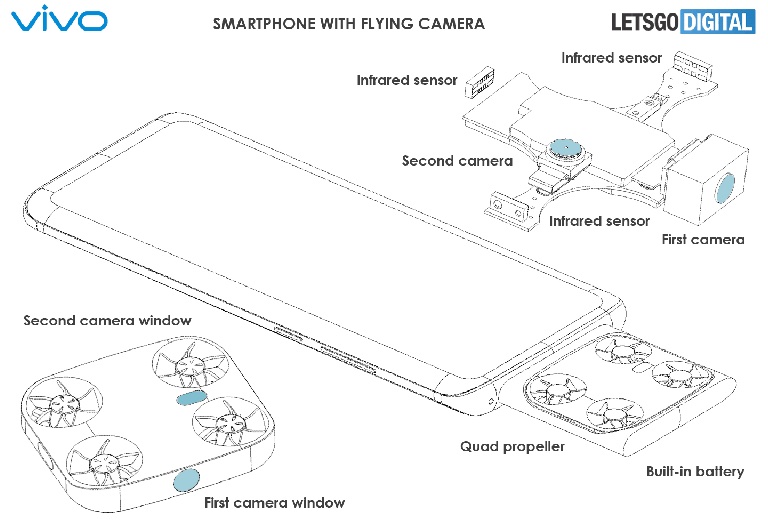
The painfully extended arm and forcibly pleased expressions seemed bad enough before selfie-sticks replaced those as the sine quo non of unabashed self-obsession. Now even those are set to be dethroned as the narcissist’s must-have gadget is a tiny, camera-equipped drone that pops from a smartphone to take aerial me-me-me photos.
Vivio files patent for phone housing tiny camera drone
Chinese smartphone manufacturer Vivio has filed a patent with the World Intellectual Property Organization for the mini phone drone, which Dutch website LetsGoDigital obtained and reported this week. The basics involve what appears to be a regular smartphone containing a cache on the top edge, from which a small quadcopter can be ejected. The mini-craft is equipped with at least two cameras and collision avoidance sensors, and is presumably piloted using the phone as a controller. All that will remain will be the shout of “cheese” for the world to be inundated with even more photos only one person will ever bother looking at.
Though not a household name like Apple or Samsung, Vivio has been active in developing new, sophisticated smartphone designs and functions, with a particular emphasis on cutting-edge photography. For now there is no drone phone information on the BKK Electronics affiliate’s web page – not surprising with the project just through the patenting stage. The development path should prove fairly challenging, however. And the pricing and marketing steps may be rather tricky as well (including ensuring people don’t get the wrong idea of what a phone designed for droning will make them sound like during calls).
Droning revolution, or price-doomed white elephant?
For starters, Vivio will have to find a way to reserve so much internal space to house the drone without seriously weakening the phone’s other functions – not to mention battery capacity. Risks of dust and water penetrating the phone’s electronic smart guts via the cache door will be another hurdle to clear.
Then there’s the drone itself. A craft that small will be unlikely to resist even mild winds, while doubtless having considerably limited battery capacity of its own. Plus, what happens if a gust blows it off or it goes missing otherwise? If iPhone history is any guide, replacement components or peripherals won’t be cheap, leaving owners with the choice of living with a droneless drone phone, or shelling out for a new craft at what may be close to the price of a regular smartphone.
That question will probably be asked by potential buyers from the get-go. Most people will carefully compare the costs of purchasing other phones as well as one of the many, affordable, portable small drones already on the market that take great shots; versus the price tag Vivio attaches to its two-in-one concept. In other words, Vivio’s flying phone will have to be utterly new, totally amazing, and just as powerful as grounded rivals, and also remain comparatively cheap.
And finally, let’s not forget that mini, camera-equipped drones already exist as standalone options – with some getting serious raspberries from dissatisfied users.
Yet doubting and nay saying have been a fixed part of early tech development for centuries – including some skeptics who claimed the iPhone concept would never work. In a decade or less, the world may look back and wonder what would have happened if Vivio drone phones hadn’t appeared to take over the leisure craft sector – and cheer everything its innovation made possible. Except even more ways to take lame selfies, that is.
FTC: We use income earning auto affiliate links. More.




Comments